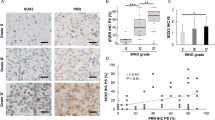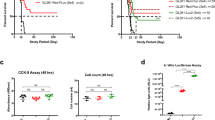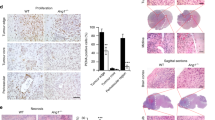Abstract
Given the failure of conventional treatments for glioblastoma, gene therapy has gained interest considerable in recent years. Gliomas are associated with a state of immunosuppression, which appears to be partially mediated by an increase in secretion of transforming growth factor-β (TGF-β) from glioma cells. Decorin, a small proteoglycan which can bind to and inactivate TGF-β, has been successfully used as an antitumor strategy on stably transfected tumor cells and has been shown to cause growth suppression in neoplastic cells of various histological origins. In this paper, we investigated the use of gene therapy to deliver the decorin transgene in a site-specific manner in an experimental model of intracranial gliomas. Our aim was to inhibit the glioma-associated immunosuppressive state, and prolong the survival of tumor-bearing rats.
We studied the effects of decorin gene transfer in the rat CNS-1 glioma model. To assess the effect of ectopic expression of decorin on glioma progression in vivo, stably transfected CNS-1 cells expressing decorin were implanted into the brain parenchyma of syngeneic Lewis rats. The rats implanted with CNS-1 cells expressing decorin survived significantly longer than those in the control groups which received CNS-1 cells that did not express decorin (P<.0001). We then investigated whether the survival observed with decorin expressing cells could be mimicked in vivo, using recombinant adenoviruses (RAds) expressing the decorin gene under the control of two different promoters: the human immediate-early cytomegalovirus (h-IE-CMV) and the glial fibrillary acidic protein (GFAP). In vivo results showed that administration of RAd expressing the human decorin under the control of h-IE-CMV promoter has a small, but significant effect in prolonging the survival of experimental tumor bearing rats (P<.0001). Our data indicate that ectopic decorin expression has the potential to slow glioma progression in vivo. Our results also indicate that expression of decorin has to be present in all cells which constitute the intracranial tumor mass for the inhibition of tumor growth and prolongation of the life expectancy of tumor-bearing rats to be effective.
This is a preview of subscription content, access via your institution
Access options
Subscribe to this journal
Receive 12 print issues and online access
$259.00 per year
only $21.58 per issue
Buy this article
- Purchase on Springer Link
- Instant access to full article PDF
Prices may be subject to local taxes which are calculated during checkout








Similar content being viewed by others
References
Iozzo RV . Matrix proteoglycans: from molecular design to cellular function. Annu Rev Biochem. 1998;67:609–652.
Kresse H, Schonherr E . Proteoglycans of the extracellular matrix and growth control. J Cell Physiol. 2001;189:266–274.
Grant DS, Yenisey C, Rose RW, Tootell M, Santra M, Iozzo RV . Decorin suppresses tumor cell-mediated angiogenesis. Oncogene. 2002;21:4765–4777.
Yamaguchi Y, Ruoslahti E . Expression of human proteoglycan in Chinese hamster ovary cells inhibits cell proliferation. Nature. 1988;336:244–246.
Santra M, Skorski T, Calabretta B, Lattime EC, Iozzo RV . De novo decorin gene expression suppresses the malignant phenotype in human colon cancer cells. Proc Natl Acad Sci USA. 1995;92:7016–7020.
De Luca A, Santra M, Baldi A, Giordano A, Iozzo RV . Decorin-induced growth suppression is associated with up-regulation of p21, an inhibitor of cyclin-dependent kinases. J Biol Chem. 1996;271:18961–18965.
Santra M, Mann DM, Mercer EW, Skorski T, Calabretta B, Iozzo RV . Ectopic expression of decorin protein core causes a generalized growth suppression in neoplastic cells of various histogenetic origin and requires endogenous p21, an inhibitor of cyclin-dependent kinases. J Clin Invest. 1997;100:149–157.
Moscatello DK, Santra M, Mann DM, McQuillan DJ, Wong AJ, Iozzo RV . Decorin suppresses tumor cell growth by activating the epidermal growth factor receptor. J Clin Invest. 1998;101:406–412.
Iozzo RV, Moscatello DK, McQuillan DJ, Eichstetter I . Decorin is a biological ligand for the epidermal growth factor receptor. J Biol Chem. 1999;274:4489–4492.
Csordas G, Santra M, Reed CC, et al. Sustained down-regulation of the epidermal growth factor receptor by decorin. A mechanism for controlling tumor growth in vivo. J Biol Chem. 2000;275:32879–32887.
Reed CC, Gauldie J, Iozzo RV . Suppression of tumorigenicity by adenovirus-mediated gene transfer of decorin. Oncogene. 2002;21:3688–3695.
Santra M, Eichstetter I, Iozzo RV . An anti-oncogenic role for decorin. Down-regulation of ErbB2 leads to growth suppression and cytodifferentiation of mammary carcinoma cells. J Biol Chem. 2000;275:35153–35161.
Stander M, Naumann U, Dumitrescu L, et al. Decorin gene transfer-mediated suppression of TGF-beta synthesis abrogates experimental malignant glioma growth in vivo. Gene Therapy. 1998;5:1187–1194.
Kiefer R, Supler ML, Toyka KV, Streit WJ . In situ detection of transforming growth factor-beta mRNA in experimental rat glioma and reactive glial cells. Neurosci Lett. 1994; 166:161–164.
Sasaki A, Naganuma H, Satoh E, et al. Secretion of transforming growth factor-beta 1 and -beta 2 by malignant glioma cells. Neurol Med Chir (Tokyo). 1995;35:423–430.
Platten M, Wild-Bode C, Wick W, Leitlein J, Dichgans J, Weller M . N-[3,4-dimethoxycinnamoyl]-anthranilic acid (tranilast) inhibits transforming growth factor-beta relesase and reduces migration and invasiveness of human malignant glioma cells. Int J Cancer. 2001;93:53–61.
Dewey RA, Morrissey G, Cowsill CM, et al. Chronic brain inflammation and persistent herpes simplex virus 1 thymidine kinase expression in survivors of syngeneic glioma treated by adenovirus-mediated gene therapy: implications for clinical trials. Nat Med. 1999;5:1256–1263.
Cowsill C, Southgate TD, Morrissey G, et al. Central nervous system toxicity of two adenoviral vectors encoding variants of the herpes simplex virus type 1 thymidine kinase: reduced cytotoxicity of a truncated HSV1-TK. Gene Therapy. 2000;7:679–685.
Lowenstein PR . Immunology of viral-vector-mediated gene transfer into the brain: an evolutionary and developmental perspective. Trends Immunol. 2002;23:23–30.
Geddes BJ, Harding TC, Lightman SL, Uney JB . Long-term gene therapy in the CNS: reversal of hypothalamic diabetes insipidus in the Brattleboro rat by using an adenovirus expressing arginine vasopressin. Nat Med. 1997;3:1402–1404.
Navarro V, Millecamps S, Geoffroy MC, et al. Efficient gene transfer and long-term expression in neurons using a recombinant adenovirus with a neuron-specific promoter. Gene Therapy. 1999;6:1884–1892.
Thomas CE, Schiedner G, Kochanek S, Castro MG, Lowenstein PR . Peripheral infection with adenovirus causes unexpected long-term brain inflammation in animals injected intracranially with first-generation, but not with high-capacity, adenovirus vectors: toward realistic long-term neurological gene therapy for chronic diseases. Proc Natl Acad Sci USA. 2000;97:7482–7487.
Thomas CE, Schiedner G, Kochanek S, Castro MG, Lowenstein PR . Preexisting antiadenoviral immunity is not a barrier to efficient and stable transduction of the brain, mediated by novel high-capacity adenovirus vectors. Hum Gene Ther. 2001;12:839–846.
Kruse CA, Molleston MC, Parks EP, Schiltz PM, Kleinschmidt-DeMasters BK, Hickey WF . A rat glioma model, CNS-1, with invasive characteristics similar to those of human gliomas: a comparison to 9L gliosarcoma. J Neurooncol. 1994;22:191–200.
Barth RF . Rat brain tumor models in experimental neuro-oncology: the 9L, C6, T9, F98, RG2 (D74), RT-2 and CNS-1 gliomas. J Neurooncol. 1998;36:91–102.
Karasuyama H, Kudo A, Melchers F . The proteins encoded by the VpreB and lambda 5 pre-B cell-specific genes can associate with each other and with mu heavy chain. J Exp Med. 1990;172:969–972.
Abe M, Harpel JG, Metz CN, Nunes I, Loskutoff DJ, Rifkin DB . An assay for transforming growth factor-beta using cells transfected with a plasminogen activator inhibitor-1 promoter-luciferase construct. Anal Biochem. 1994;216:276–284.
Trojan J, Johnson TR, Rudin SD, Ilan J, Tykocinski ML . Treatment and prevention of rat glioblastoma by immunogenic C6 cells expressing antisense insulin-like growth factor I RNA. Science. 1993;259:94–97.
Beutler AS, Banck MS, Aguzzi A . Curing rat glioblastoma: immunotherapy or graft rejection? Science. 1997;276:20–21.
Parsa AT, Chakrabarti I, Hurley PT, et al. Limitations of the C6/Wistar rat intracerebral glioma model: implications for evaluating immunotherapy. Neurosurgery. 2000;47:993–999; discussion 999–1000.
Yamaguchi Y, Mann DM, Ruoslahti E . Negative regulation of transforming growth factor-beta by the proteoglycan decorin. Nature. 1990;346:281–284.
Border WA, Noble NA, Yamamoto T, et al. Natural inhibitor of transforming growth factor-beta protects against scarring in experimental kidney disease. Nature. 1992;360:361–364.
Isaka Y, Brees DK, Ikegaya K, et al. Gene therapy by skeletal muscle expression of decorin prevents fibrotic disease in rat kidney. Nat Med. 1996;2:418–423.
Takeuchi Y, Kodama Y, Matsumoto T . Bone matrix decorin binds transforming growth factor-beta and enhances its bioactivity. J Biol Chem. 1994;269:32634–32638.
Morelli AE, Larregina AT, Smith-Arica J, et al. Neuronal and glial cell type-specific promoters within adenovirus recombinants restrict the expression of the apoptosis-inducing molecule Fas ligand to predetermined brain cell types, and abolish peripheral liver toxicity. J Gen Virol. 1999;80(Part 3):571–583.
Smith-Arica JR, Morelli AE, Larregina AT, et al. Cell-type-specific and regulatable transgenesis in the adult brain: adenovirus-encoded combined transcriptional targeting and inducible transgene expression. Mol Ther. 2000;2:579–587.
Munz C, Naumann U, Grimmel C, Rammensee HG, Weller M . TGF-beta-independent induction of immunogenicity by decorin gene transfer in human malignant glioma cells. Eur J Immunol. 1999;29:1032–1040.
Tralhao JG, Schaefer L, Micegova M, et al. In vivo selective and distant killing of cancer cells using adenovirus-mediated decorin gene transfer. FASEB J. 2003;17:464–466.
Gerdes CA, Castro MG, Lowenstein PR . Strong promoters are the key to highly efficient, noninflammatory and noncytotoxic adenoviral-mediated transgene delivery into the brain in vivo. Mol Ther. 2000;2:330–338.
Shering AF, Bain D, Stewart K . Cell type-specific expression in brain cell cultures from a short human cytomegalovirus major immediate early promoter depends on whether it is inserted into herpesvirus or adenovirus vectors. J Gen Virol. 1997;78(Part 2):445–459.
Lowenstein PR, Shering AF, Bain D, Castro MG, Wilkinson GWG . The use of adenovirus vectors to transfer genes to identified target brain cells in vitro. In: P.R.a.E. Lowenstein LW, eds. Protocols for Gene Transfer in Neuroscience. Chichester: John Wiley and Sons; 1996: 93–114.
Southgate T, Kingston P, Castro MG . Gene transer into neural cells in vivo using adenoviral vectors. In: Gerfen CR, McKay R, Rogawski MA, Sibley DR, Skolnick P, eds. Current Protocols in Neuroscience. New York, NY: John Wiley and Sons; 2000: 4.23.1–4.23.40.
Dion LD, Fang J, Garver Jr RI . Supernatant rescue assay vs. polymerase chain reaction for detection of wild type adenovirus-contaminating recombinant adenovirus stocks. J Virol Methods. 1996;56:99–107.
Cotten M, Baker A, Saltik M, Wagner E, Buschle M . Lipopolysaccharide is a frequent contaminant of plasmid DNA preparations and can be toxic to primary human cells in the presence of adenovirus. Gene Therapy. 1994;1:239–246.
Thomas CE, Abordo-Adesida E, Maleniak TC, Stone D, Gerdes G, Lowenstein PR . Gene transfer into rat brain using adenoviral vectors. In: Gerfen JN, McKay R, Rogawski MA, Sibley DR, Skolnick P, eds. Current Protocols in Neuroscience. New York, NY, John Wiley and Sons; 2000: 4.23.1–4.23.40.
Stone D, Xiong W, Williams JC, David A, Lowenstein PR, Castro MG . Adenovirus expression of IL-1 and NF-kappaB inhibitors does not inhibit acute adenoviral-induced brain inflammation, but delays immune system-mediated elimination of transgene expression. Mol Ther. 2003;8:400–411.
Acknowledgements
The neurological gene therapy program in the GTRI is funded by NIH Grants 1 RO1 NS42893 (PRL), 1 RO1 NS44556 (MGC), U54 4 NS04-5309 (PRL), R21 NS47298 (PRL), 1 RO3 TW006273-01A1 (MGC), and the Kane Fellowship in Gene Therapy for Cancer Research. PRL holds the Bram and Elaine Goldsmith Chair in Gene Therapeutics. We would also like to thank the Board of Governors at Cedars-Sinai Medical Center for their vision and very generous creation and support of the GTRI. During his PhD work, Dr Ali Biglari was very generously supported by a fellowship from the Government of the Republic of Iran. We would like to thank Dr Shlomo Melmed for his support and academic leadership, Mr Richard Katzman for his first class administrative support, Mrs Semone Muslar for her excellent secretarial skills, and Mr Nelson Jovel for the skillful and top quality editing and preparation of the figures and manuscript for publication.
Author information
Authors and Affiliations
Corresponding authors
Rights and permissions
About this article
Cite this article
Biglari, A., Bataille, D., Naumann, U. et al. Effects of ectopic decorin in modulating intracranial glioma progression in vivo, in a rat syngeneic model. Cancer Gene Ther 11, 721–732 (2004). https://doi.org/10.1038/sj.cgt.7700783
Received:
Published:
Issue Date:
DOI: https://doi.org/10.1038/sj.cgt.7700783
Keywords
This article is cited by
-
Proteoglycans in prostate cancer
Nature Reviews Urology (2012)
-
Rat brain tumor models in experimental neuro-oncology: the C6, 9L, T9, RG2, F98, BT4C, RT-2 and CNS-1 gliomas
Journal of Neuro-Oncology (2009)
-
Astrocytic expression of transgene in the rat brain mediated by baculovirus vectors containing an astrocyte-specific promoter
Gene Therapy (2006)
-
Protection of Adult Mouse Progenitor Cells and Human Glioma Cells by de novo Decorin Expression in an Oxygen- and Glucose-Deprived Cell Culture Model System
Journal of Cerebral Blood Flow & Metabolism (2006)
-
Transforming growth factor-β in cancer and metastasis
Cancer and Metastasis Reviews (2006)



